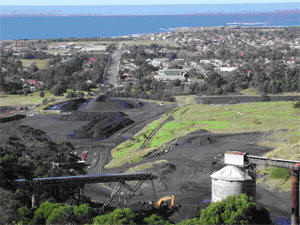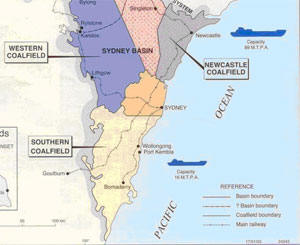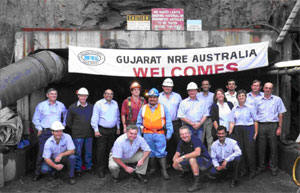| NRE
No. 1 Colliery
| The
NRE No. 1 Colliery (erstwhile South Bulli Colliery)
was acquired by Gujarat NRE Coke Ltd., through its subsidiary
Gujarat NRE Australia Pty Ltd. in December 2004. The
mine located in the Southern Coalfields of New South
Wales, approximately 10 kilometers north of Wollongong
and around 60 kilometers south of Sydney in Australia
will ensure a steady supply of high quality raw material
for its coke ovens operations in India and provide insurance
against price volatility.
Regional
Geology
The NRE No 1 colliery holding is
surrounded to the north, south and west by other collieries.
Geologically, the region is generally referred to as
the Southern Coalfield, which is part of the Sydney
Basin of New South Wales and is situated towards the
southernmost extremity of the Sydney
- Bowen Basin of eastern Australia.
|

|
|
|
The colliery holding is adjacent to the south eastern margin
of the basin. Depositionally, the basin had been active during
Permian and Triassic times with phases of tectonism and/or
igneous activity extending from Permian to recent times. In
the Southern Coalfield, the general sequence, from top to
bottom, consists of the Hawkesbury Sandstone, the Narrabeen
Group, and the Illawarra Coal Measures. There are at least
seven phases of cyclic sedimentation in Sydney sub-group.
The most important of these depositional cycles are
the three sequences at the top of
the Sydney sub-group, which contain, from
bottom to top, the Wongawilli coal seam, the Balgownie
coal seam, and the Bulli coal seam. |
| 
|
The
Bulli seam lies immediately below the Coal Cliff sandstone
of the Narrabeen Group. The Illawarra Coal Measures
are underlain in the Wollongong area by marine sediments
of the Upper Shoalhaven Group.
Mine Geology
The mine spread over 6421 hectares and having reserves
of around 300 million tonnes of coking coal comprises
three coal seams, the Bulli seam, which occurs at the
top of the Illawarra Coal Measures, the Balgownie seam,
some 8 to 10 metres below it, and the Wongawilli seam,
which lies between 22 and 25 metres below the Balgownie
seam. Two minor seams, the Cape Horn seam and the Hargraves
seam, lie between the Balgownie and
Wongawilli seams, but are too
thin to have any economic significance. The average
seam thicknesses of the Bulli, Balgownie and Wongawilli
seams are 2.01 metres, 1.25 metres, and 9.75 metres
respectively,
|
|
| though
only the basal 2.5 metres of the Wongawilli seam is regarded
as the working section. The Bulli seam has been worked extensively
in the mine area for almost 120 years, the Balgownie seam
was worked between 1967 and 1982 and again in 2002, but there
has been no systematic production from the Wongawilli seam
in this colliery. Both the Balgownie and the Wongawilli seams
are largely untapped resources.
Bulli Seam
The Bulli seam lies at the top of the Illawarra Coal Measures.
It outcrops on the eastern slope of the Illawarra Escarpment,
and lies beneath some 450 metres of younger rocks towards
the western part of the colliery. This seam has been worked
extensively in this colliery for almost 120 years, since 1887.
The Bulli seam is predominantly comprised of dull to dull
banded coal with some brighter content towards the base of
the seam; some included thin stone bands, often sideritic,
form regionally consistent markers. The working section of
the seam varies in thickness from 1.63 metres to 2.72 metres,
and averages 2.01 metres. The in situ ash content of the Bulli
seam averages approximately 16.7 per cent. Around 84% to 82%
of recoverable coal is predicted as marketable with yields
coking coal to thermal coal ranging from 66:18 to 70:14.
|
|
The Balgownie Seam
The Balgownie seam lies within 7 and 13 metres below
the Bulli seam throughout the Mine. It was mined between
1967 and 1982 and again in 2002. The thickness of the
Balgownie seam ranges from 0.46 to 1.50 metres, and
is usually between 1.22 and 1.35 metres. The top 1.0
metre (approx) of the seam is regarded to be of better
quality than the base, which consists of interbedded
coal and mudstones. The in situ ash content of the Balgownie
seam varies from 12 to 25 per cent, but is seldom above
18 per cent.
The Balgownie coal has very low phosphorous levels typically
<0.05 and <0.5 for sulphur. Thus,
there is a high demand
|
 |
for it, for blending low phosphorous coals with
high phosphorous iron ore. The Bulli also has low sulphur
levels typically <0.5 although phosphorous is usually
1.0 so the blended product (Balgo) is high quality hard
coking coal with low phosphorous and low sulphur by
world standards. It has always been regarded as an attractive
additive to Bulli seam blends, due to its favourable
swelling properties and its low phosphorous content.
|
|
|
Wongawilli Seam
The Wongawilli seam lies between 22 and 25 meters below the
Balgownie seam with resources totaling around 200 million
tonnes. Geologically the Wongawilli seam in this area is generally
8 - 9 metres in thickness. The projected working section,
near the base of the seam, is usually in the range of 2.2
� 2.5 metres thick, thinning to less than 2.0 metres towards
the holding boundaries in the far north and east.
The seam is quite banded with the majority of coal plies being
dull and bright. The coal plies are concentrated in the lower
half of the seam. The upper half of the seam grades upward
from coal to interbedded coal and carbonaceous and tuffaceous
sedimentary rocks. Coal is generally duller in the upper part
of the seam. Disseminated siderite, and calcite on cleat,
is common.
Highlights
of the Mine
The Market Demand
for "Balgo"
The coal products from the NRE No. 1 Colliery are world
class due to their very low phosphorous levels (<0.005ppm),
high calorific value, low ash coal and low sulphur contents
and their suitability for direct feed into coke oven to produce
blast furnace coke, ranked among the best in the world.
The
low phosphorous levels in Balgownie Seam coal (Balgo) represent
some of the lowest known levels of phosphorous in the world.
The merits of the Balgownie low volatile metallurgical coals
are:
-
Strong
coke
-
Low
phosphorous
-
Low
sulphur
-
Good
Fluidity
-
Nil
oven wall pressure
-
Adequate
reflectance
There
is also a strong, diversified demand for the Bulli coals,
due to its quality characteristics. By mining to produce a
blend of Balgownie and Bulli coal, the quality of both the
hard coking coal and the thermal coal products are enhanced.
The low phosphorous coking coal will be a premium product
in the world coal market and be in high demand by European
steel mills.
Historically iron ore mines concentrated on mining low phosphorous
iron ore deposits. Such deposits have been heavily exploited
over the last 30 years and as a consequence mines are now
forced to mine deposits with higher concentrations of phosphorous.
The availability of low phosphorous coking coal offsets the
issue of high phosphorous iron ore facing the iron ore miners
and steel mills. There is also potential to prepare a third
saleable product, PCI coal, which is intermediate in value
between coking and thermal coal.
Methane Gas Reserves
There is
scope to develop extensive high quality methane gas resources
(estimated in excess of 50 years), existing within the Wongawilli
seam which contains the largest field of gas in the region.
The presence of gas up to 10m3/t with acceptable CO2 ratios
in the Bulli and Balgownie seams may also be exploited for
gas sales or power generation. Government incentives and grants
are available in projects, which reduce greenhouse gas (methane)
emissions for which the Balgownie project may qualify.
The NRE No. 1 Colliery acquired as a measure of backward
integration has made Gujarat NRE Coke Limited the first and
only coke manufacturer in India to have a captive prime coking
coal mine overseas. It will ensure a steady supply of high
quality raw material for its coke ovens operations in India
in a highly volatile environment and save purchase costs.
The colliery will also create employment in the Illawarra
area and in India with benefits to both the nations.
|
© Copyright 2005 GNCL.
All Rights Reserved. A SteelRX
creation.
|